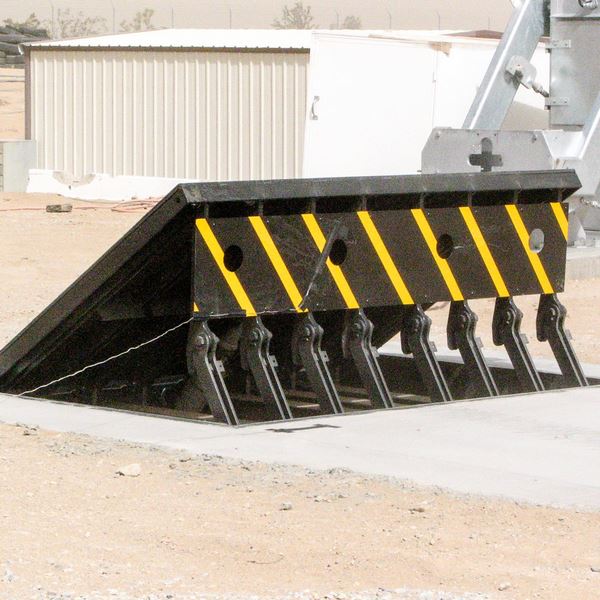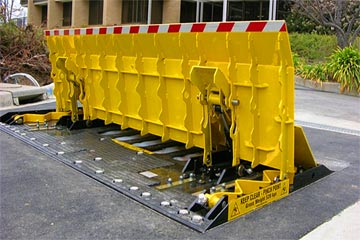Getting My Wedge Barriers To Work
The Best Guide To Wedge Barriers
Table of ContentsThe Greatest Guide To Wedge BarriersOur Wedge Barriers PDFs


18 may be done faster, quickly, and price successfully. FIG. In certain personifications, the anchor 30 might be a steel structure including plates, light beams(e. g., I-beams ), and/or other frameworks that are secured within the foundation 14, which might be concrete. At the surface 12, a top side 28 of the support 30 may go to the very least partially subjected
, thereby allowing the add-on of the barrier 10 to the support 30. g., threaded openings)in several light beams or plates of the support 30 may be subjected to the surface area 12. In this manner, screws 32 or various other mechanical fasteners may be made use of to secure the barrier 10 to the anchor 30. As the obstacle 10 is placed to the surface 12 of the foundation 14, collection of particles and other material beneath the barrier might be reduced, and elements of the bather 10 may not be subjected to listed below quality atmospheres. As shown by recommendation character 52, the training mechanism 50 includes elements got rid of beneath the wedge plate 16. The parts 52 beneath the wedge plate 16 may consist of an electromechanical actuator, a web cam, one or more web cam surfaces, and so forth. In addition, the training system 50 includes a spring assembly 54
The spring pole 58 is paired to a camera(e. g., webcam 80 displayed in FIG. 4) of the lifting device 50. The springtimes 60 disposed regarding the springtime pole 58 are kept in compression by springtime supports 62, including a fixed springtime assistance 64. That is, the set springtime assistance 64 is taken care of about the structure 14 and the remainder of the bather 10.
Wedge Barriers for Dummies
g., spring assistance 65 )may be dealt with to the end of the spring pole 58 to enable compression of the springtimes 60. As the springtimes 60 are pressed in between the springtime supports 62, the spring assembly 54 creates a pressure try these out acting on the web cam combined to the springtime pole 58 in a direction 66. The continuing to be force applied to
the cam to deploy release wedge plate 16 may might provided offered an electromechanical actuator 84 or other various other. Therefore, the springtime setting up 54 and the actuator 84(e. g., electromechanical actuator)may run with each other to equate the camera and lift the wedge plate 16.
As stated over, the spring setting up 54 puts in a constant pressure on the cam, while the electromechanical actuator might be managed to apply a variable force on the cam, consequently enabling the training and lowering( i. e., deploying and withdrawing )of the wedge plate 16. In particular personifications, the constant force applied by the spring setting up 54 might be adjustable. g., electromechanical actuator) is handicapped. As will be appreciated, the springtime setting up 54 might be covered and safeguarded from particles or other elements by a cover plate(e. g., cover plate 68 received FIG. 4) that might be substantially flush with the raised surface area 38 of the structure 14. As stated above, in the released setting, the wedge plate 16 serves to block accessibility or traveling beyond the barrier 10. For example, the barrier 10(e. g., the wedge plate 16 )may block pedestrians or cars from accessing a building or path. As gone over above, the obstacle 10 is connected to the Click This Link support 30 safeguarded within the foundation 14,

front brackets 71. Consequently, the affiliation assemblies 72 may pivot and turn to allow the collapse and expansion of the linkage assemblies 72 throughout retraction and deployment of the bather 10. The linkage settings up 72 cause activity of the wedge plate 16 to be limited. If an automobile is taking a trip in the direction of the deployed wedge plate 16(e. For instance, in one scenario, the safety and security legs 86 may be prolonged throughoutmaintenance of the barrier 10. When the safety legs 86 are deployed, the safety and security legs 86 support the weight of the wedge plate 16 against the surface area 12. Consequently, the lifting device 50 might be deactivated, serviced, gotten rid of, changed, etc. FIG. 5 is partial viewpoint sight of a personification of the surface-mounted wedge-style barrier 10, illustrating the camera 80 and the cam surfaces 82 of the training mechanism 50. Particularly, 2 cam surfaces 82, which are referred to as lower cam surfaces 83, are positioned listed below the webcam Visit Your URL 80. The lower web cam surface areas 83 might be taken care of to the surface 12 (e. As an example, the reduced camera surface areas 83 and the mounting plate 85 might create a single piece that is safeguarded to the anchor 30 by screws or various other mechanical bolts. Additionally, two web cam surface areas 82, which are described as upper cam surfaces 87, are placed above the cam 80 and combined to (e. In various other embodiments, interfering layers or plates might be positioned between the surface 12 and the reduced webcam surface areas 83 and/or the wedge plate 16 and the upper webcam surfaces 87 As stated over, the web cam
80 converts along the webcam surfaces 82 when the wedge plate 16 is lifted from the pulled back placement to the released setting. In addition, as discussed above, the springtime assembly 54 (see FIG. 3 )may provide a force acting upon the web cam 80 in the instructions 102 via springtime rod 58, which might lower the force the electromechanical actuator 84 is needed to relate to the webcam 80 in order to actuate and raise the wedge plate 16. 1 )to the deployed setting(see FIG. 4). As shown, the web cam 80 consists of track wheels 104(e. g., rollers), which get in touch with and equate along the camera surface areas 82 during procedure.